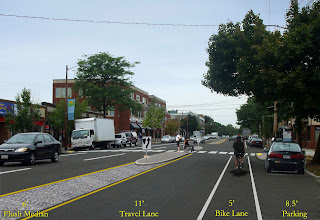The following column was originally published in the February 21 2013 Arlington Advocate. It is reprinted here with permission of the author.
Despite an extensive public process now entering its fifth year, MassDOT will hold another Mass Ave Corridor Plan public hearing on Tuesday February 26 at Town Hall.
 |
| The view west towards Capitol Square with new design features superimposed. More here. |
Opponents continue to push for more traffic lanes than are needed. They insist that without at least four continuous traffic lanes through East Arlington, Mass Ave will suffer “crippling” traffic congestion. In fact, numerous traffic counts and analysis have ALL said otherwise.
The most-recent traffic modeling by both the Town’s and DOT’s engineers have determined that the difference between a three-lane and a four-lane Mass Ave is—drum roll, please—26 additional seconds when driving the entire one mile corridor…in the year 2028…only while driving westbound….only between 5:00-6:00pm and, in all likelihood, only when school is in session
What proponents of a four-lane roadway—five lanes at major intersections—won’t tell you is that there is a steep price to pay if they are successful in derailing the project. Unless parking is removed from one side of Mass Ave to make additional space, a four-lane plan would jeopardize the $5 million in federal and state funding because it does not meet MassDOT standards and guidelines.
There are also numerous safety, aesthetic and environmental benefits that can only be gained with a three-lane plan. These would disappear entirely if Mass Ave were rebuilt with an unnecessary fourth travel lane.
Pedestrian Safety
The most critical need on Mass Ave is for pedestrians to be able to cross more safely and easily. This is the #1 complaint for nearly everyone who walks along Mass Ave. All non-signalized crosswalks in the current plan will cross only three traffic lanes, reducing by 50% the “multi-lane threat” that makes crossing four-lane roadways nerve-racking and dangerous
There will likely be median islands in the two crosswalks that “bookend” Capitol Square at Grafton/Orvis and Marathon Street. Pedestrians will have a refuge between the two directions of traffic
These safety features are not feasible if Mass Ave were rebuilt with an unnecessary fourth travel lane.
Urban Design at Capitol Square
Sidewalks along the Capitol Theater block are too narrow for a vibrant business district. Newspaper boxes, utility poles, bike racks and trash bins crowd parents pushing strollers and queues waiting to enter the theater.
The current plan would widen the narrow sidewalks in the heart of Capitol Square by 4-5 feet. Doing so provides space for outdoor seating, temporary displays from businesses, trees, and landscaping.
Wider sidewalks also reduce the time needed for the pedestrian-only crossing phase at the Lake Street traffic light, permitting more green time for vehicles.
These improvements to the heart of the business district are not feasible if Mass Ave were rebuilt with an unnecessary fourth travel lane.
Bicycle Accessibility and Safety
State policies require appropriate accommodations for bicycles on major roadway projects. For a street as wide as Mass Ave with its traffic volumes and speeds, separate bike lanes are by far the best accommodation.
Dedicated space for bikes means more-predictable behavior. It reduces driver swerving to pass bikes on the road. This benefits traffic flow and safety.
The bike lanes also provide space for buses to pull in and out and for cars to parallel park without blocking traffic. The parking lane will be ten feet wide through most of the corridor, plenty of buffer space for bicyclist to avoid car doors.
The project would not meet state standards for bike accessibility if Mass Ave were rebuilt with an unnecessary fourth travel lane.
A New Mass Ave
Moving forward with the current plan, construction will be complete in late 2014. The road will accommodate traffic and parking roughly as it does today. Cars, buses, and trucks will drive more predictably.
Sudden lane shifts and U-turns will be less frequent. The street will be safer to cross and more inviting to walk from end to end.
Mass Ave will be a greener corridor with dozens of new street trees and additional landscaped areas. It will be a more-vibrant business district where all of today’s legal parking spaces remain, but access to businesses will be more walkable.
If you share this not-so-radical vision, please attend the 7pm, February 26 Public Hearing and tell DOT that you support the three-lane plan. Mass Ave does not need to remain a four-lane highway through our neighborhood. Indeed, that’s a bad deal for Arlington.
For more information, see www.ealscoalition.org.
Phil Goff lives in East Arlington and is the founder and co-chair of the East Arlington Livable Streets (EALS) Coalition.